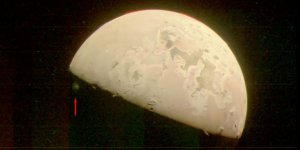| News / Space News |
Scientists Discover a Novel Galactic ‘Fossil’
Researchers at NASA’s Goddard Space Flight Center in Greenbelt, Maryland, have discovered X-ray activity that sheds light on the evolution of galaxies.

Sites of active star formation appear bright pink in this visible light image captured by the European Southern Observatory’s 2.2-meter telescope in Chile. The galaxy’s active core is mostly concealed by a cloud of dust. Photo: ESO
The X-rays outline giant clouds of cold gas in the nearby spiral galaxy NGC 4945. The gas appears to have blasted through the galaxy after its central supermassive black hole erupted some 5 million years ago.
“There’s ongoing debate in the scientific community about how galaxies evolve,” said Kimberly Weaver, an astrophysicist at Goddard who led the work.
“We find supermassive black holes in the centers of nearly all Milky Way-sized galaxies, and an open question is how much influence they have compared to the effects of star formation. Studying nearby galaxies like NGC 4945, which we think we’re seeing in a transition period, helps us build better models of how stars and black holes produce galactic changes.”
NGC 4945 is an active galaxy about 13 million light-years away in the southern constellation Centaurus.
An active galaxy has an unusually bright and variable center powered by a supermassive black hole that heats a surrounding disk of gas and dust through gravitational and frictional forces.
The black hole slowly consumes the material around it, which creates random fluctuations in the disk’s emitted light. As with most active galaxies, NGC 4945’s black hole and disk are shrouded by a dense cloud of dust called a torus, which blocks some of that light.
The cores of active galaxies can also drive jets of high-speed particles and generate strong winds containing gas and dust.
NGC 4945 is also a starburst galaxy, which means it forms stars at a much higher rate than our own.
Scientists estimate it produces the equivalent mass of 18 stars like our Sun every year, or nearly three times the rate of the Milky Way. Almost all the star formation is concentrated in the galaxy’s center.
A starburst event lasts between 10 and 100 million years, ending only when the raw material to make new stars is depleted.
Weaver, NASA’s project scientist for XMM-Newton, and her team looked at NGC 4945 with the satellite. In their data, they saw what scientists call the iron K-alpha line.
This feature occurs when very energetic X-ray light from the black hole’s disk meets cold gas elsewhere. (The gas measures around minus 400 degrees Fahrenheit or minus 200 Celsius.)
The iron line is common in active galaxies, but until these observations, scientists previously thought it occurred on scales much closer to the black hole.
“Chandra has mapped iron K-alpha in other galaxies. In this one, it helped us study individual bright X-ray sources in the cloud to help us rule out other potential origins besides the black hole,” said Jenna Cann, a co-author and postdoctoral researcher at Goddard. “But NGC 4945’s line extends so far from its center that we needed XMM-Newton’s wide field of view to see all of it.”
Because NGC 4945 is tilted nearly edge-on from our point of view, XMM-Newton was able to map the extent of its iron line both along and above the galaxy’s plane, tracing it out to 32,000 and 16,000 light-years, respectively – an order of magnitude farther than previously observed iron lines.
The science team thinks the cold gas highlighted by the line is a relic of a particle jet erupting from the galaxy’s central black hole about 5 million years ago. The jet was likely angled into the galaxy rather than pointing into space, driving a superpowered wind that’s still pushing cold gas through the galaxy. It may even have triggered the current starburst event.
Weaver and her colleagues will continue to observe NGC 4945 to see if they can discover other ways the black hole is affecting the galaxy’s evolution.
The same X-rays from the disk that are currently highlighting the cold gas may also begin to dissipate it. Since stars would need that gas to form, scientists might be able to measure how activity around a galaxy’s black hole can quench its starburst phase.
YOU MAY ALSO LIKE





